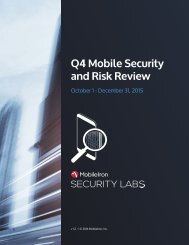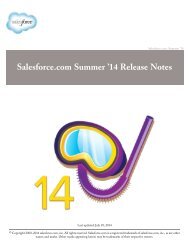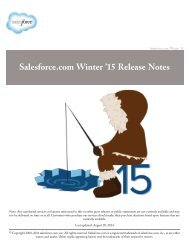salesforce_security_impl_guide
salesforce_security_impl_guide
salesforce_security_impl_guide
You also want an ePaper? Increase the reach of your titles
YUMPU automatically turns print PDFs into web optimized ePapers that Google loves.
Securing and Sharing Data<br />
Creating and Editing Groups<br />
• Create groups with at least a few users who need the same access.<br />
• Create groups with members who don’t frequently need to be moved in or out of the groups.<br />
• Avoid creating groups within groups that result in more than five levels of nesting.<br />
• Enable automatic access to records using your role hierarchies in public groups by selecting Grant Access Using Hierarchies when<br />
creating a group. However, deselect this option if you’re creating a public group with All Internal Users as members.<br />
Creating and Editing Groups<br />
Only administrators can create and edit public groups, but anyone can create and edit their own<br />
personal groups.<br />
To create or edit a group:<br />
1. Click the control that matches the type of group:<br />
• For personal groups, go to your personal settings and click My Personal Information or<br />
Personal—whichever one appears. Then click My Groups. The Personal Groups related<br />
list is also available on the user detail page.<br />
• For public groups, from Setup, click Manage Users > Public Groups.<br />
2. Click New, or click Edit next to the group you want to edit.<br />
3. Enter the following:<br />
Field<br />
Label<br />
Group Name (public groups only)<br />
Description<br />
The name used to refer to the group in any user<br />
interface pages.<br />
The unique name used by the API and managed<br />
packages. The name must begin with a letter and use<br />
only alphanumeric characters and underscores. The<br />
name cannot end with an underscore or have two<br />
consecutive underscores.<br />
EDITIONS<br />
Available in:<br />
• Professional<br />
• Enterprise<br />
• Performance<br />
• Unlimited<br />
• Developer<br />
• Database.com<br />
USER PERMISSIONS<br />
To create or edit a public<br />
group:<br />
• “Manage Users”<br />
To create or edit another<br />
user’s personal group:<br />
• “Manage Users”<br />
Grant Access Using<br />
Hierarchies (public groups<br />
only)<br />
Select Grant Access Using Hierarchies to allow<br />
automatic access to records using your role hierarchies.<br />
When selected, any records shared with users in this<br />
group are also shared with users higher in the hierarchy.<br />
Deselect Grant Access Using Hierarchies if you’re<br />
creating a public group with All Internal Users as<br />
members, which optimizes performance for sharing<br />
records with groups.<br />
Note: If Grant Access Using Hierarchies is<br />
deselected, users that are higher in the role<br />
hierarchy don’t receive automatic access.<br />
However, some users—such as those with the<br />
“View All” and “Modify All” object permissions<br />
and the “View All Data” and “Modify All Data”<br />
73






